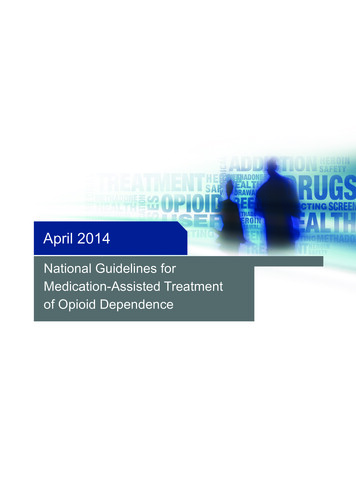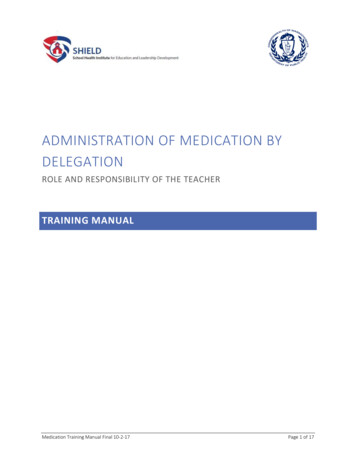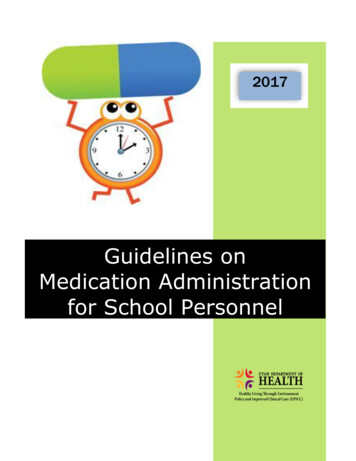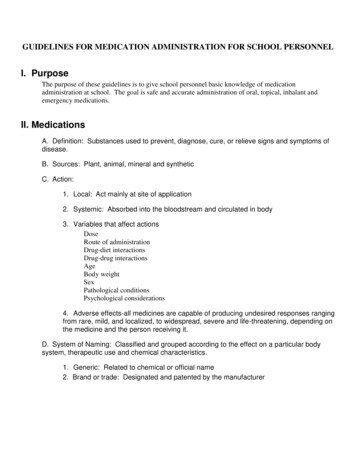
Transcription
April 2014National Guidelines forMedication-Assisted Treatmentof Opioid Dependence
National Guidelines forMedication-Assisted Treatmentof Opioid DependencePrint ISBN: 978-1-74241-944-2Online ISBN: 978-1-74241-945-9Publications approval number: 10253Copyright Statements Commonwealth of Australia 2014Paper-based publicationsThis work is copyright. You may reproduce the whole or part of this work in unaltered formfor your own personal use or, if you are part of an organisation, for internal use withinyour organisation, but only if you or your organisation do not use the reproduction for anycommercial purpose and retain this copyright notice and all disclaimer notices as part of thatreproduction. Apart from rights to use as permitted by the Copyright Act 1968 or allowed bythis copyright notice, all other rights are reserved and you are not allowed to reproduce thewhole or any part of this work in any way (electronic or otherwise) without first being giventhe specific written permission from the Commonwealth to do so. Requests and inquiriesconcerning reproduction and rights are to be sent to the Online, Services and ExternalRelations Branch, Department of Health, GPO Box 9848, Canberra ACT 2601,or via e-mail to copyright@health.gov.au.Internet sitesThis work is copyright. You may download, display, print and reproduce the whole or part ofthis work in unaltered form for your own personal use or, if you are part of an organisation,for internal use within your organisation, but only if you or your organisation do not use thereproduction for any commercial purpose and retain this copyright notice and all disclaimernotices as part of that reproduction. Apart from rights to use as permitted by the CopyrightAct 1968 or allowed by this copyright notice, all other rights are reserved and you are notallowed to reproduce the whole or any part of this work in any way (electronic or otherwise)without first being given the specific written permission from the Commonwealth to do so.Requests and inquiries concerning reproduction and rights are to be sent to the Online,Services and External Relations Branch, Department of Health, GPO Box 9848, CanberraACT 2601, or via e-mail to copyright@health.gov.au.Designed by Graphic Language Design www.gldesign.com.au
National Guidelines forMedication-Assisted Treatmentof Opioid DependenceAuthorsLinda GowingDrug & Alcohol Services South Australia andDiscipline of Pharmacology, the University of AdelaideRobert AliDrug & Alcohol Services South Australia andDiscipline of Pharmacology, the University of AdelaideAdrian DunlopDrug and Alcohol Services for Newcastle,New South Wales HealthMike FarrellNational Drug & Alcohol Research Centre,the University of New South WaleNick LintzerisDrug and Alcohol Services for South EasternSydney Area Health ServiceNational Guidelines for Medication-Assisted Treatment of Opioid Dependencei
ntroduction1Opioid use in AustraliaNature of opioid dependenceTreatment approaches to opioid dependenceStructure of treatment in AustraliaClinical governance and the role of guidelines11245About this document6ScopeStructureProcess for development of guidelinesGrading of guidelinesTerminology67788Part A Guidelines for Medication-Assisted Treatmentof Opioid Dependence9A1ASSESSMENT10A1.1Reason for treatment10A1.2Assessing substance use and previous treatment10A1.2.1A1.2.2A1.2.3A1.2.4HistoryPhysical and mental state examinationInvestigationsDiagnosing substance use disorders10101111A1.3Assessment of other health and social issues12A2TREATMENT PLANNING13A2.1Situations that may influence treatment .7Polydrug useAcute medical conditionsPsychiatric comorbidityChronic pain syndromes and pharmaceutical opioid dependencePeople with a recent interruption to regular opioid useChild protectionDifficulties attending dosing facilities15151515161616National Guidelines for Medication-Assisted Treatment of Opioid Dependenceii
CoverContentsA3Detoxification17A3.1Objectives of detoxification17A3.2Settings for withdrawal18A3.3Supportive care and monitoring18A3.4Patient information18A3.5Medication approaches for withdrawal19A3.6Planning services after withdrawal20A4SUBSTITUTION TREATMENT21A4.1Choice of medication21A4.2Induction22A4.2.1Methadone(a) Recommended regimen for outpatients withunsanctioned use of opioids(b) Recommended regimens for patients transferring fromprescribed pharmaceutical opioid preparations(c) Recommended approach to transfer patients frombuprenorphine to methadoneBuprenorphine(a) Recommended induction regimen for outpatients usingheroin and/or short-acting pharmaceutical opioids.(b) Recommended buprenorphine induction regimen for patientsusing methadone or sustained-release pharmaceutical opioids.22A4.3Delivering safe and effective agonist maintenance treatment29A4.3.1Optimising medication dosing regimensMethadoneBuprenorphineTakeaways and unsupervised dosingIntoxicated presentationsMissed doses Doses missed on 1,2 or 3 consecutive days Doses missed on 4 or 5 consecutive days Doses missed on more than 5 consecutive days Reviewing patients who repeatedly miss doses29293031323233333334A4.3.2Clinical review and monitoringUrine drug screeningContinued drug vingComorbid medical conditions373738A4.2.2National Guidelines for Medication-Assisted Treatment of Opioid Dependence232424242526iii
ContentsA4.4SafetyA4.4.4Cardiac functionBackgroundAssessment prior to initiating methadoneResponding to QTc prolongation during treatmentDrug interactions3838383940A4.5Side effects40A4.6Cessation of substitution treatment41A4.6.1Involuntary withdrawal43A5Relapse prevention: Naltrexone maintenance .3Factors affecting treatment selection44A5.4Initiating treatment45A5.5Delivering safe and effective naltrexone treatment46A5.6Monitoring and review47A6Psychosocial support48A7Issues that may impact on treatment49A7.1Pregnancy and breastfeeding49A7.2Age factors51A7.2.1A7.2.2AdolescentsOlder drug users5151A7.3Comorbid mental health conditions52A7.4Prisoners52A7.5Infectious diseases52A7.6Management of pain53A7.7Smoking cessation54A8Consumer information and perspective55A9Good clinical practice57A9.1Linkages between prescriber, dispenser and adjunct services57A9.2Response to administration of incorrect dose of medication57A10Jurisdictional issues59A10.1Patient transfers59A10.2Travelling overseas with methadone, buprenorphine or naltrexone59A10.3Authorisation, training and support of prescribers and dispensers60A10.4Criteria for takeaways and unsupervised dosing61A4.4.5(continued)National Guidelines for Medication-Assisted Treatment of Opioid Dependenceiv
ContentsPart B: Supporting Information631.Context for the guidelines641.1Opioid use in Australia641.1.1Patterns of use641.1.2Consequences of unsanctioned opioid use64MortalityCrimeBlood-borne virus infections6565651.2Treatment response661.2.11.2.21.2.31.2.4Goals of treatmentPatient perspective: the treatment journeyImportance of integrationTypes of treatment Screening and brief intervention Detoxification Substitution treatment (agonist maintenance) Relapse prevention Living skills development6668707273737475752.Treatment approaches in Australia772.1Medications description and pharmacology772.1.1Methadone77Absorption and duration of actionMetabolismSafety and side on and duration of actionMetabolismSafety and side effectsPrecipitated bility842.2.Detoxification852.2.1Nature of opioid withdrawal852.2.2Aim of detoxification872.2.3Medications to manage withdrawalAdrenergic agonistsBuprenorphineTapered methadoneUse of opioid antagonists in detoxificationSetting for detoxificationAdjunct therapies in detoxificationSelection of ational Guidelines for Medication-Assisted Treatment of Opioid Dependencev
Contents2.3Agonist pharmacotherapy (opioid substitution treatment)2.3.12.3.22.3.32.3.42.3.5Aims of substitution treatmentEffectiveness of substitution treatmentChoosing between methadone and buprenorphinePsychosocial supportInduction into substitution treatment Methadone BuprenorphineMaintenance doses Methadone Buprenorphine Takeaways and unsupervised dosingAdverse effects Overdose– Methadone– Buprenorphine Sexual dysfunction Prolongation of QTc interval Drug interactionsCompleting substitution treatment When to end treatment Process of cessation– Methadone– Buprenorphine Aftercare and e prevention: Naltrexone maintenance treatment1122.4.12.4.2Effectiveness of naltrexone treatmentInitiating naltrexone treatment Commencing naltrexone followingbuprenorphine maintenance treatmentDose and duration of treatmentSupportive care for patients on naltrexoneAdjunct pharmacotherapies Antidepressants Symptomatic medicationsUndesirable effects and consequencesPromoting medication compliance1121132.4.32.4.42.4.52.4.62.4.7National Guidelines for Medication-Assisted Treatment of Opioid Dependence113114114115115115115116vi
Contents2.5Adjunct therapies1172.5.1Psychological Factors in TreatmentStages of change Pre-contemplation stage Contemplation stage Preparation stage Action stage Maintenance of change s of counsellingCognitive-behavioural approachesMotivational InterviewingCommunity reinforcement and contingency managementSocial Behaviour and Network Therapy (SBNT)Relapse prevention1221221221221231232.5.3Setting for counselling1252.5.4Psychosocial supportSelf-help groupsAftercare1251261272.6Issues that may impact on treatment1282.6.1Aboriginal and Torres Strait Island People1282.6.2Women1292.6.3Pregnancy and breastfeedingPregnant opioid users not in treatmentPregnancy and opioid substitution treatmentNaltrexone treatment and pregnancyManaging pregnancyDose reductions or detoxification during pregnancyNeonatal .4Parenting and child protection issues1362.6.5Adolescents1372.6.6Comorbid mental health conditionsDepressionAnxietyPsychosisPersonality disordersPost-traumatic stress disorder138140141141142142National Guidelines for Medication-Assisted Treatment of Opioid Dependencevii
Contents2.6.72.6.82.6.92.6.102.6.11Polydrug usePolydrug use and substitution treatmentTreating polydrug useSmoking cessation treatmentBenzodiazepinesInfections in injecting drug usersHIV/AIDSHepatitis A and BHepatitis CPrisonersManagement of painAcute pain in patients receiving pharmacotherapiesfor opioid dependenceChronic pain Assessment and diagnosis Management plan Rationalise medications Maintain accurate documentationOther health issuesSleep disturbancesDrivingDental 1511511521531531531533.Quality framework1543.1Assessment and treatment engagement1541543.2Establishing and defining a therapeutic relationship3.3Treatment planning1573.4Case management or care coordination1583.5Reviewing treatment progress1593.6Records and reporting161National Guidelines for Medication-Assisted Treatment of Opioid Dependenceviii
ContentsReferences163Glossary of terms and abbreviations180Appendix 1: Definitions of opioid dependence183Diagnostic and Statistical Manual of Mental Disorders183International Classification of Diseases, 10th edition (ICD-10):184Appendix 2: Assessment of opioid withdrawal185Objective Opioid Withdrawal Scale (OOWS)186Subjective Opiate Withdrawal Scale (SOWS)187The Short Opiate Withdrawal Scale (ShOWS)188Clinical Opiate Withdrawal Scale (COWS)189Modified Finnegan Scale for Neonates191Appendix 3: Clinically significant interactions betweenmethadone, buprenorphine and other medications1921. Increased sedative effects1922. Withdrawal symptoms or adverse effects1933. Prolongation of QTc interval1934. Effects on other medications193Appendix 4: Management of acute opioid withdrawalprecipitated by naltrexone194Introduction194Precipitated withdrawal194Diagnosis and assessment194Management195Additional management195Appendix 5: Withdrawal states from commonly used drugs196Appendix 6: Signs of intoxication with commonly used drugs197Appendix 7: Detection times for selected drugs in urine198National Guidelines for Medication-Assisted Treatment of Opioid Dependenceix
ContentsAppendix 8: Equivalent opioid doses199Appendix 9: ATOP200Appendix 10: Prevention and management of opioid overdose202Knowing what puts you at risk of an overdose202Know the signs202What to do if someone has an overdose203Calling an ambulance203Appendix 11: Further reading and resources204State and Territory Government Services204New South WalesVictoriaQueenslandWestern AustraliaSouth AustraliaTasmaniaNorthern TerritoryAustralian Capital Territory204204204204205205205205Commonwealth Government Services and Agencies205National Services206National Organisations207Useful documents and websites207Index209National Guidelines for Medication-Assisted Treatment of Opioid Dependencex
National Guidelines forMedication-Assisted Treatmentof Opioid DependenceAcknowledgementsThe authors acknowledge input from the Commonwealth Department of Health and aconsultative group comprising Michael Aufgang (RACGP), Sue Ballantyne (QueenslandHealth), Denis Leahy (Pharmacy Guild), Laura Santana (AIVL), Sam Liebelt (AIVL),Anna Keoto (NSW Health), Annie Madden (AIVL), Michael McDonough (Health Victoria),Natasha Perry (Hunter-New England Health), Nghi Phung (Australasian Chapter ofAddiction Medicine), Angelo Pricolo (Pharmacy Guild), Allan Quigley (Health WA),Adrian Reynolds (Tasmania Health).This document updates and replaces four previously separate documents: National Pharmacotherapy Policy for People Dependent on Opioids; Clinical guidelines and procedures for the use of methadone in the maintenancetreatment of opioid dependence; National clinical guidelines and procedures for the use of buprenorphine in themaintenance treatment of opioid dependence; and Clinical Guidelines and Procedures for the Use of Naltrexone in the Management ofOpioid Dependence.These documents have informed the development of this version; the indirectcontribution of the authors of these earlier documents is acknowledged.The work to develop these guidelines was commissioned by the IntergovernmentalCommittee on Drugs (IGCD) through the National Drug Strategy Cost Shared FundingModel.DisclaimerThis document is a general guide to appropriate practice, to be followed subject to theclinician’s judgement and patient’s preference in each individual case. The guidelineis designed to provide information to assist decision-making and is based on the bestavailable evidence at the time of development of this publication.Please Note: Tasmania endorses the overall thrust of the guidelines as an importantand much needed national guide for clinicians to use in treating opioid dependence, butdoes not endorse the framework or criteria for takeaways and unsupervised dosing.All links to websites and phone numbers included in this document were current at thetime text was finalised.The authors have previously received funding from Reckitt Benckiser in the form ofuntied educational grants. Reckitt Benckiser had no role in the preparation of thisdocument.National Guidelines for Medication-Assisted Treatment of Opioid Dependencexi
National Guidelines forMedication-Assisted Treatmentof Opioid DependenceForewordThis document marks a substantial step forward in the evolution of treatment for opioiddependence in Australia. It consolidates four, previously separate, documents into one,and reflects accrued experience with buprenorphine. More importantly, it seeks to makethe guidelines more clearly evidence-based and useful for service providers, policymakers and consumers. The term “medication-assisted treatment of opioid dependence”that has been used in the title is a more encompassing term than “pharmacotherapy”and is increasingly being used to refer to the different treatment approaches thatcombine medication and psychosocial support for people who are opioid dependent.Providing a broad policy context and framework with a view to promoting a nationalstandard whilst recognising jurisdictional responsibilities and the need for flexibility toaccommodate different jurisdictional approaches is a complex task. The efforts of allinvolved in providing and drawing together diverse viewpoints and expertise to producethis document are greatly appreciated. I hope the end result is practical, useful andinformative.ChairAUSTRALIAN HEALTHMINISTERS’ ADVISORY COUNCILNational Guidelines for Medication-Assisted Treatment of Opioid Dependencexii
CoverNational Guidelines forMedication-Assisted Treatmentof Opioid DependenceIntroductionOpioid use in AustraliaLess than 1% of the Australian population aged 14 years and over will have used heroinor another opioid for non-medical purposes in the last year1. Despite the low prevalenceof use, the economic and social cost of opioid drug use is relatively high due to: loss of life through fatal overdose, with deaths related to heroin and other opioidsoccurring at a much younger age than deaths attributed to alcohol or tobacco; treatment of overdose and other medical consequences of injecting drug use; transmission of hepatitis C, hepatitis B and HIV; community loss due to criminal activity; law enforcement and judicial costs; and loss of quality of life for users and their families, including personal and economiccost of imprisonment.Heroin, and opioid dependence in general, is a major area of focus for drug and alcoholtreatment services because the harms are disproportionate to the prevalence of use.Nature of opioid dependenceThe key feature of dependence is a loss of control over use, which is seen as continueduse despite drug-related legal, interpersonal and health problems as well as drug usetaking priority over other activities and obligations.LINKAppendix 1: Definitionsof opioid dependenceThe reasons why people start taking alcohol and other drugs are diverse. Initial andongoing use is influenced by a range of risk and protective factors that are biological,sociological and psychological in nature.Risk factorsProtective factorsIndividual personalitySelf-controlParental attitudesParental monitoring and supportChaotic home environmentPositive social environmentDrug availability and effectsPositive relationshipsSocial environmentAcademic competenceNot all people who use drugs become dependent. As with any other medical condition,individual vulnerability to dependence is determined by the mix of risk and protectivefactors, but with repeated drug use biological factors become important. It is estimatedthat genetic factors account for between 40 and 60 percent of a person’s vulnerability toaddiction, including the effects of environment on gene expression and function2.Australian Institute of Health and Welfare 2011. 2010 National Drug Strategy Household Surveyreport. Drug statistics series no 25. Cat. No. PHE 145. Canberra: AIHW. www.aihw.gov.au.Accessed 4 April 2012.12Drugs, brains and behaviour. The science of addiction. National Institute on Drug Abuse, USDepartment of Health and Human Services, August 2010. Available from www.drugabuse.gov.Accessed 15/5/2013.National Guidelines for Medication-Assisted Treatment of Opioid Dependence1
CoverIntroductionThe age of first use, route of administration and individual response to drug user are allfactors that influence the likelihood of initial drug use progressing through regular useto dependence. Continued use leads to physiological and neurobiological changes thatin turn lead to physical dependence manifested as withdrawal on cessation of use, andongoing craving predisposing to resumption of drug use (Koob & Volkow, 2010).Dependent drug users tend to show greater impulsiveness; make choices based onimmediate benefit, with little regard to long term negative consequences; and show poorimpulse control, arising from a lack of activity in the area of the brain responsible for“executive function”. Factors that affect the “executive” area of brain function (such asplanning, problem-solving and interpreting risk) include: characteristics of the person (genetics, early experiences) stage of brain maturation (this is one of the last areas of the brain to completedevelopment, at around 25 years of age; consequently adolescents are morevulnerable to the development of problematic drug use) and brain damage, due to injury or neurotoxicity of drug use.Drugs are thought to act through systems in the brain that have their origin in responsesto stimuli that are relevant to preservation of the species (food, sex, fight and flightbehaviour). In drug addiction, drug-seeking becomes the focus at the expense of naturalrewards. The continual activation of the structures in the brain by drug use causeschanges in neuronal systems that “hard-wire” the memory of drug use as a sourceof “reward” and necessary for survival. It is this in-built memory that makes addictsvulnerable to long-term relapse (meaning a return to problematic drug use) and is thebasis of the chronic relapsing nature of drug dependence (Koob & Volkow, 2010).Treatment approaches to opioid dependenceThe chronic relapsing nature of drug dependence has resulted in addiction beingcompared with other chronic, relapsing medical conditions such as asthma, hypertensionand diabetes. The similarities of these conditions are striking: genetic, personal choice and environmental factors play comparable roles in theaetiology and course for all these conditions; rates of relapse and adherence to medication are similar; there is no reliable cure, however compliance with treatment is associated with morefavourable outcomes; people who are older, employed, with stable families and long-term relationships aremore likely to comply with treatment and have positive treatment outcomes than thosewho are younger, unemployed and with less stable family support; and best outcomes are achieved with treatment that combines medication and behaviouralinterventions.To become drug free, dependent users have to overcome the compulsion of drug use,ongoing cravings and the physical adaptation to chronic drug use. They also have todeal with psychological and social issues that may comprise both the underlying reasonsNational Guidelines for Medication-Assisted Treatment of Opioid Dependence2
CoverIntroductionfor using drugs and the consequences of a drug-using lifestyle. The more severe andlong-standing the dependence, the less alternative interests the person has to revertto – social exclusion is common. This social complexity means that recovery fromdrug dependence is likely to entail substantial physical, psychological and lifestylereadjustments – a process that typically requires a long period of time. Many people whodevelop addiction as a complication of opioid treatment of chronic, non-malignant painmay have a lesser degree of social exclusion, but the combination of pain and addictioncan also result in complex treatment needs.Medication assisted treatment of opioid dependence (MATOD) is a combination ofmedication (methadone or buprenorphine for substitution treatment, or naltrexone forrelapse prevention treatment) and psychosocial support. The medications eliminatewithdrawal, control or eliminate cravings or block the euphoric effect of further opioiduse, while psychosocial support refers to the many ways in which the psychologicalhealth and the social environment of the opioid user can be addressed, to help improveboth the quality and duration of life. Assistance can range from the simple (e.g. provisionof food and shelter) to the complex (e.g. structured psychotherapy). Psychosocialsupport provided as a component of MATOD should be phased and layered to reflectchanging patient needs over time, with the style and content adapted to fit preparednessfor change and cognitive capacity3.Medications used in MATOD are of two broad types: opioid agonists and antagonists. Methadone, morphine, heroin, oxycodone and hydromorphone are all full opioidagonists. These drugs bind to and activate mu opioid receptors in the brain.Increasing doses of full agonists produce increasing effects.LINK Naltrexone and naloxone are examples of opioid antagonists. These drugs alsobind to mu opioid receptors in the brain, but do not activate them. In binding to thereceptors antagonists prevent the receptors from being activated by agonists. Henceantagonists are blocking agents.See glossary fordefinition of antagonistSee glossary fordefinition of agonist Buprenorphine is a partial mu opioid agonist. It binds to the mu opioid receptorsin the brain and activates them, but not to the same degree as full agonists. Theconsequence of this is that there is a ceiling effect, with the effect of buprenorphinereaching a maximum level that is not increased further even with increasing dosesof buprenorphine. Like antagonists, partial agonists occupy receptors and preventfurther activation by a full agonist.The pharmacological properties of methadone and buprenorphine are such that they canbe substituted for problematic opioid drugs, referred to as opioid substitution treatment(OST). As a blocking agent naltrexone is used in abstinence-oriented programs tosupport relapse prevention. Inherent in these guidelines is the concept that, for peoplewho are opioid dependent, abstinence is not easily achieved or maintained. WhileNational Treatment Agency for Substance Misuse (2012). Medications in recovery: Reorientating drugdependence treatment. Available from n-report3.pdf,Accessed 3 April 2013.3National Guidelines for Medication-Assisted Treatment of Opioid Dependence3
CoverIntroductionmedication alone can bring about some behavioural change (Schwartz, Kelly, O’Grady,Gandhi, & Jaffe, 2012; Yancovitz et al., 1991), psychosocial support is seen as critical tosustainable change. Hence the definition of MATOD incorporates psychosocial supportas an inherent component. Recovery from addiction involves multiple pathways andprocesses that are unique in timing and characteristics for every individual (Walter Ling,Farabee, Liepa, & Wu, 2012). Treatment of opioid dependence involves building ongains and enhancing the resolve and commitment for behaviour change, which may alsobe referred to as “recovery capital” as is appropriate for each individual. This typicallyinvolves monitoring progress in treatment over time and establishing multiple, achievablemilestones to map a treatment pathway. In the course of a treatment pathway, goalsare likely to change making ongoing goal-setting essential. At different points onthe pathway, emphasis may be on quality of life, and reduction of problematic riskbehaviours. Abstinence from drug use may arise from behavioural change, but will notnecessarily be a goal throughout the treatment pathway.LINK1.2.2 Patientperspective: thetreatment journeyGlossary of termsand abbreviationsStructure of treatment in AustraliaOptimising the benefits of MATOD requires a balance between access and quality.Making a drug widely available improves access, but may compromise the qualityand safety of treatment. Restricting a drug to being used only in specialist settingslimits its usefulness as an intervention. In general, the balance between accessibilityand quality is best maintained when general practitioners are trained to prescribepharmacotherapies, and are able to refer patients or to consult with specialist drug andalcohol services.Jurisdictions vary in their requirements for treatment services. Access will be optimalwhere the model of service delivery involves general practitioners and other healthservice providers, supported by specialist drug and alcohol services, with jurisdictionalmonitoring and regulation.Pharmacological treatment of opioid dependence should be accessible to all those inneed, including those in prison and other closed settings (WHO, 2009). The principlesof MATOD outlined by this document largely apply to both correctional and communitysettings but there are a range of constraints that impact on the implementation ofMATOD for people in prison and in the criminal justice system. The link betweencommunity and correctional services systems is particularly important, and it is thisaspect that is given attention in this document.Integration of opioid dependence treatment into primary care is one way to increaseaccessibility, although it may not be possible in all settings. Primary care practitionerswill usually need support from the specialist system, through mentoring, training,consultation and referral. Treatment in primary care has the advantage of integratingaddiction medical and psychiatric services into mainstream services, reducing the stigmaof addiction and the professional isolation of medical staff. Integration also reducessome of the problems that clinics can develop when large numbers of patients on opioidagonist maintenance are aggregated (WHO, 2009).National Guidelines for Medication-Assisted Treatment of Opioid Dependence4
CoverIntroductionProvision of opioid substitution treatment in a specialist clinic setting enables a rangeof services to be brought together and provides the means of specialist support toprimary health care settings. Treatment may also be collaborative with prescribing andcounselling in specialist clinics, and dispensing of medication in community settings.Clinical governance and the role of guidelinesClinical care should be informed by and consistent with evidence based treatmentguidelines. These guidelines seek to adopt a framework appropriate to support qualityuse of medicines.
National Guidelines for Medication-Assisted Treatment of Opioid Dependence Print ISBN: 978-1-74241-944-2 Online ISBN: 978-1-74241-945-9 Publications approval number: 10253










